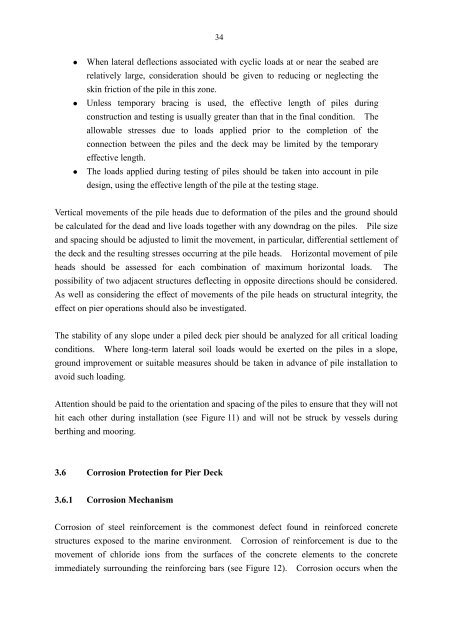Port Works Design Manual : Part 2
Port Works Design Manual : Part 2
Port Works Design Manual : Part 2
- No tags were found...
You also want an ePaper? Increase the reach of your titles
YUMPU automatically turns print PDFs into web optimized ePapers that Google loves.
34• When lateral deflections associated with cyclic loads at or near the seabed arerelatively large, consideration should be given to reducing or neglecting theskin friction of the pile in this zone.• Unless temporary bracing is used, the effective length of piles duringconstruction and testing is usually greater than that in the final condition. Theallowable stresses due to loads applied prior to the completion of theconnection between the piles and the deck may be limited by the temporaryeffective length.• The loads applied during testing of piles should be taken into account in piledesign, using the effective length of the pile at the testing stage.Vertical movements of the pile heads due to deformation of the piles and the ground shouldbe calculated for the dead and live loads together with any downdrag on the piles. Pile sizeand spacing should be adjusted to limit the movement, in particular, differential settlement ofthe deck and the resulting stresses occurring at the pile heads. Horizontal movement of pileheads should be assessed for each combination of maximum horizontal loads. Thepossibility of two adjacent structures deflecting in opposite directions should be considered.As well as considering the effect of movements of the pile heads on structural integrity, theeffect on pier operations should also be investigated.The stability of any slope under a piled deck pier should be analyzed for all critical loadingconditions. Where long-term lateral soil loads would be exerted on the piles in a slope,ground improvement or suitable measures should be taken in advance of pile installation toavoid such loading.Attention should be paid to the orientation and spacing of the piles to ensure that they will nothit each other during installation (see Figure 11) and will not be struck by vessels duringberthing and mooring.3.6 Corrosion Protection for Pier Deck3.6.1 Corrosion MechanismCorrosion of steel reinforcement is the commonest defect found in reinforced concretestructures exposed to the marine environment. Corrosion of reinforcement is due to themovement of chloride ions from the surfaces of the concrete elements to the concreteimmediately surrounding the reinforcing bars (see Figure 12). Corrosion occurs when the
















